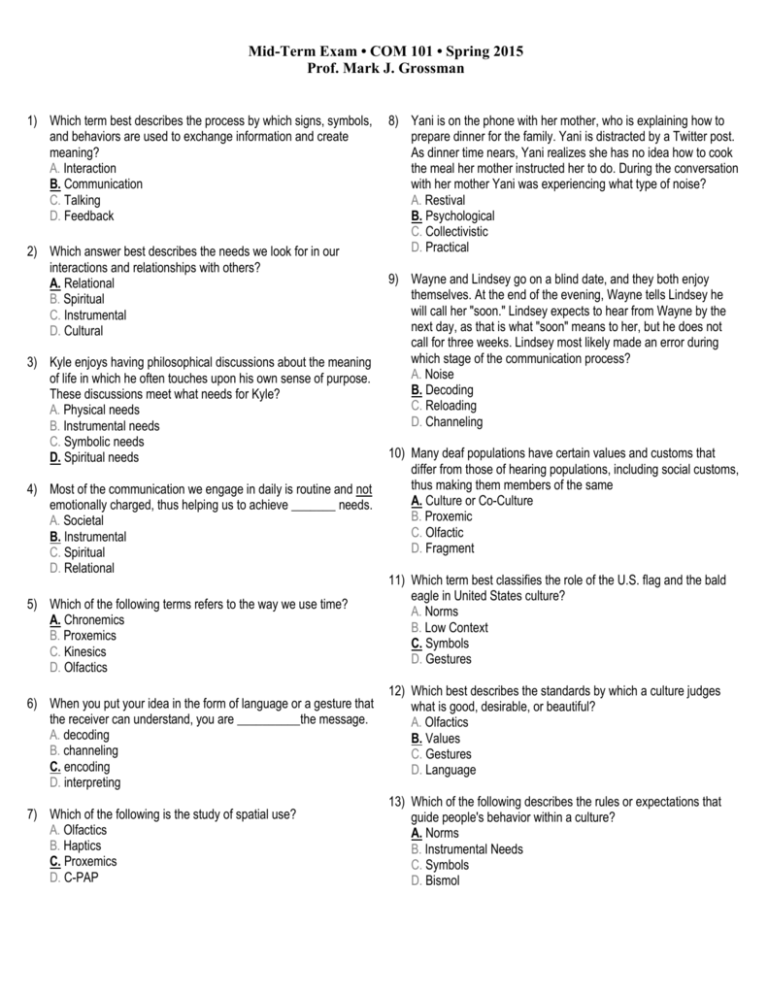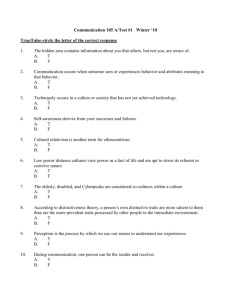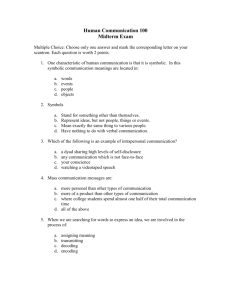Chapter 01 Communication: A First Look
advertisement

Mid-Term Exam • COM 101 • Spring 2015 Prof. Mark J. Grossman 1) Which term best describes the process by which signs, symbols, and behaviors are used to exchange information and create meaning? A. Interaction B. Communication C. Talking D. Feedback 2) Which answer best describes the needs we look for in our interactions and relationships with others? A. Relational B. Spiritual C. Instrumental D. Cultural 3) Kyle enjoys having philosophical discussions about the meaning of life in which he often touches upon his own sense of purpose. These discussions meet what needs for Kyle? A. Physical needs B. Instrumental needs C. Symbolic needs D. Spiritual needs 4) Most of the communication we engage in daily is routine and not emotionally charged, thus helping us to achieve _______ needs. A. Societal B. Instrumental C. Spiritual D. Relational 5) Which of the following terms refers to the way we use time? A. Chronemics B. Proxemics C. Kinesics D. Olfactics 6) When you put your idea in the form of language or a gesture that the receiver can understand, you are __________the message. A. decoding B. channeling C. encoding D. interpreting 7) Which of the following is the study of spatial use? A. Olfactics B. Haptics C. Proxemics D. C-PAP 8) Yani is on the phone with her mother, who is explaining how to prepare dinner for the family. Yani is distracted by a Twitter post. As dinner time nears, Yani realizes she has no idea how to cook the meal her mother instructed her to do. During the conversation with her mother Yani was experiencing what type of noise? A. Restival B. Psychological C. Collectivistic D. Practical 9) Wayne and Lindsey go on a blind date, and they both enjoy themselves. At the end of the evening, Wayne tells Lindsey he will call her "soon." Lindsey expects to hear from Wayne by the next day, as that is what "soon" means to her, but he does not call for three weeks. Lindsey most likely made an error during which stage of the communication process? A. Noise B. Decoding C. Reloading D. Channeling 10) Many deaf populations have certain values and customs that differ from those of hearing populations, including social customs, thus making them members of the same A. Culture or Co-Culture B. Proxemic C. Olfactic D. Fragment 11) Which term best classifies the role of the U.S. flag and the bald eagle in United States culture? A. Norms B. Low Context C. Symbols D. Gestures 12) Which best describes the standards by which a culture judges what is good, desirable, or beautiful? A. Olfactics B. Values C. Gestures D. Language 13) Which of the following describes the rules or expectations that guide people's behavior within a culture? A. Norms B. Instrumental Needs C. Symbols D. Bismol 14) Perry, a U.S. American student, and Sun Yi, his girlfriend from Taiwan, are arguing. While Perry expresses himself loudly, Sun Yi tries a less aggressive approach. They both grow more and more frustrated, as Perry thinks Sun Yi won't address the conflict directly and Sun Yi thinks Perry is behaving selfishly. What perceptual influence could be at work in this situation? A. Primacy B. Spodek C. Culture D. Ragtime 20) If you define yourself as a male, an uncle, and someone who is fun and honest, you are defining different aspects of your A. Locus B. Organization C. Identity D. Self-Serving Bias 21) The only reason English speakers use the word dog when it doesn't actually look or sound like one is because they have agreed to give the word dog that particular meaning, thus showing the _______________ nature of language. 15) Chin believes her primary responsibility is to her family, A. Static community and employer. She considers the needs of her family, B. Fixed friends, and co-workers more important than her own needs. This C. Rule-Governed example illustrates what type of culture? D. Arbitrary A. Collectivistic B. Irresponsible 22) Much of what we learn about what someone is thinking or how C. Low power-distance they are feeling comes not through listening to their words but D. Monochronic through observing their body language and other behaviors. Body language is an example of what kind of communication? 16) Research shows that the U.S., Canada, Great Britain, and A. Verbal Australia are the most highly B. Johari A. Abstract Cultures C. Denotative B. Collectivistic Cultures D. Non-verbal C. Stereotypical D. Individualistic Cultures 23) The Ashanti tribe in Africa has a proverb that says "The poor man and the rich man do not play together." This proverb not only 17) A ________________ is a generalization about a group or influences the ways tribal members see the world, but also category of people that can have a powerful influence on how we reflects the attitudes and behaviors of the tribe's people. This perceive other people and their communicative behavior. example illustrates what concept? A. Stereotype A. Ladder of abstraction B. Locus B. Sapir-Whorf hypothesis C. Construct C. The locus of language D. Denotation D. Complexity of language 18) We have a tendency to remember information that supports our stereotypes while forgetting information that doesn't. Which of the 24) When you learn a new language, you must also learn new _______ rules, so you know the correct pronunciation of words. following best describes this tendency? A. Semantic A. Denotative B. Recency B. Self-fulfilling prophecy C. Phonological C. Selective memory bias D. Pragmatic D. Fundamental attribution error 19) A stand-up comedian's last joke is one of the most important jokes because of which principle? A. Perceptual effect B. Recency effect C. Primary effect D. Construct effect 25) Ross and Emma have been dating for a few months. One evening, Ross tells Emma he loves her, by which he means he likes spending time with her and enjoys her company. Emma understands this word to mean Ross is going to stay with her forever and she can plan on a long-term commitment. Which term refers to a difference in meaning, like that of the word love? A. Definition B. Literal C. Denotative D. Connotative 26) Researchers identify symmetry and proportionality as primary contributors to facial A. Ambiguity B. Expressions C. Attractiveness D. Selective Planning 33) Patrick indicates size with his hands while describing the fish he caught. His body motions are A. taking the place of words or phrases B. expressing control C. displaying ambiguity D. regulating communication 27) Which of the following refers to the active process of making meaning out of another person's spoken message? A. Hearing B. Listening C. Randomness D. Olfactics 34) The saying "opposites attract" might seem true because we are often attracted by A. Proximity B. Appearance C. Complementarity D. Similarity 28) ______________ is merely the perception of sound. A. Listening B. Selecting C. Hearing D. Interpreting 29) Research suggests that close relationships help people manage the negative effects of stress because social relationships bring ______________ rewards. A. Material B. Basic C. Health D. Mnemonic 35) If you can trace the progression of an idea from living creatures, to animals, to mammals, to canines, to cocker spaniels, to your pet named Lucy, what are you following? A. Semantics B. Ambiguity C. The Sapir-Whorf Hypothesis D. The Ladder of Abstraction 36) The Merriam-Webster Dictionary defines the word persuasion as "an opinion held with complete assurance." This is the _____________ meaning of the word. A. Arbitrary B. Denotative C. Connotative 30) The tendency not to listen to anything with which one disagrees is D. Random known as A. Chronemics 37) Shaking hands with someone upon meeting them is an example B. Proximity of ___________ touch in North America. C. Glazing Over A. Selective D. Closed-Mindedness B. Affectionate C. Ritualistic 31) If Rebecca chooses not to share her history of childhood abuse D. Material with friends, what area of Rebecca's Johari window would that information be located in? 38) When you first meet someone, the ____________________ A. Hidden or Secret theory suggests you will find not knowing about that person to be B. Blind unpleasant, so you'll be motivated to find out more information. C. Unknown A. Uncertainty Reduction D. Noise B. Attraction C. Relational Maintenance 32) If Marissa thinks about the events of last evening while she is D. Social Exchange listening to a classroom lecture, these thoughts would be considered A. Noise B. Feedback C. Johari D. Channels 39) Much of the listening you do in class is ________ listening. A. Olfactic B. Empathic C. Informational D. Ritualistic 40) Which of the following strategies encourages you to identify as many ideas as possible without stopping to evaluate them? A. Brainstorming B. Creating C. Interpreting D. Listening 46) Language whose technical meaning is understood by people within a given culture or co-culture but not necessarily by those outside it is what type of communication code? A. Jargon B. Symbols C. Idioms D. Norms 47) In individualistic cultures, the _____ is valued more than the _____. (Choose a word pair from below that completes both blanks.) A. Individual/Group B. Individual/Johari C. Social World/Familial World 41) Good public speakers engage in ______________, which means D. Concept/Image thinking carefully about the characteristics of their listeners so they can address their audience in the most effective way. 48) Believing that your culture is better than another is known as A. self-analysis A. Egocentrism B. collectivist cultural activities B. Ethnocentrism C. psychoanalysis C. Patriotism D. audience analysis D. Altruism 42) Which of the following is NOT a demographic characteristic? 49) Idioms are A. Age A. Words that describe something that can be sensed B. Socioeconomic status B. Our personal symbolic system C. Mood C. Arbitrary symbols used to name things D. Academic achievements D. Expressions whose meaning differs from the literal meanings 43) _____ sensitive speakers recognize that many minorities have histories of social, economic, or political oppression. A. Rhetorically B. Culturally C. Monochronic D. Connotative 44) Which of the following is NOT a visual element of delivery? A. Facial expressions B. Eye contact C. Articulation D. Gestures 45) A ________________ is a generalization about a group or category of people that can have a powerful influence on how we perceive other people and their communicative behavior. A. stereotype B. perceptual set C. construct D. characteristic 50) Low power distance cultures are characterized by A. leaders who are feared and respected B. great differences in power distribution C. an equal distribution of power D. polite forms of language and address






